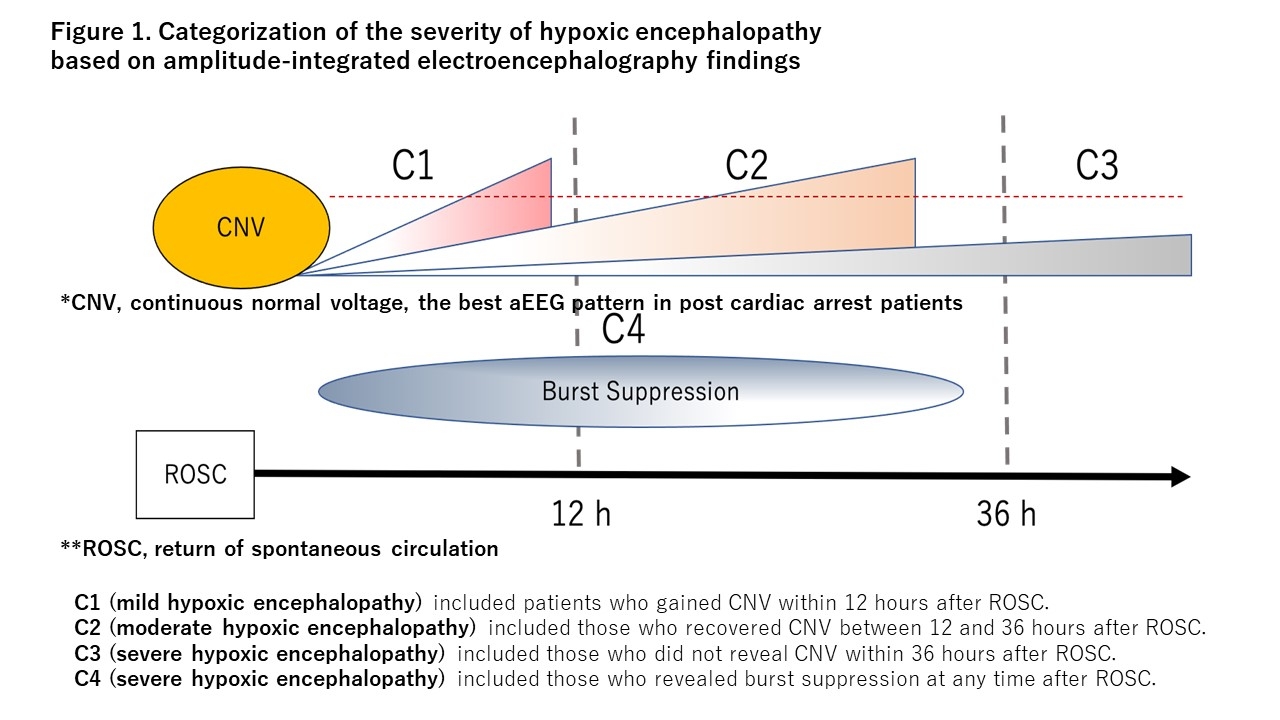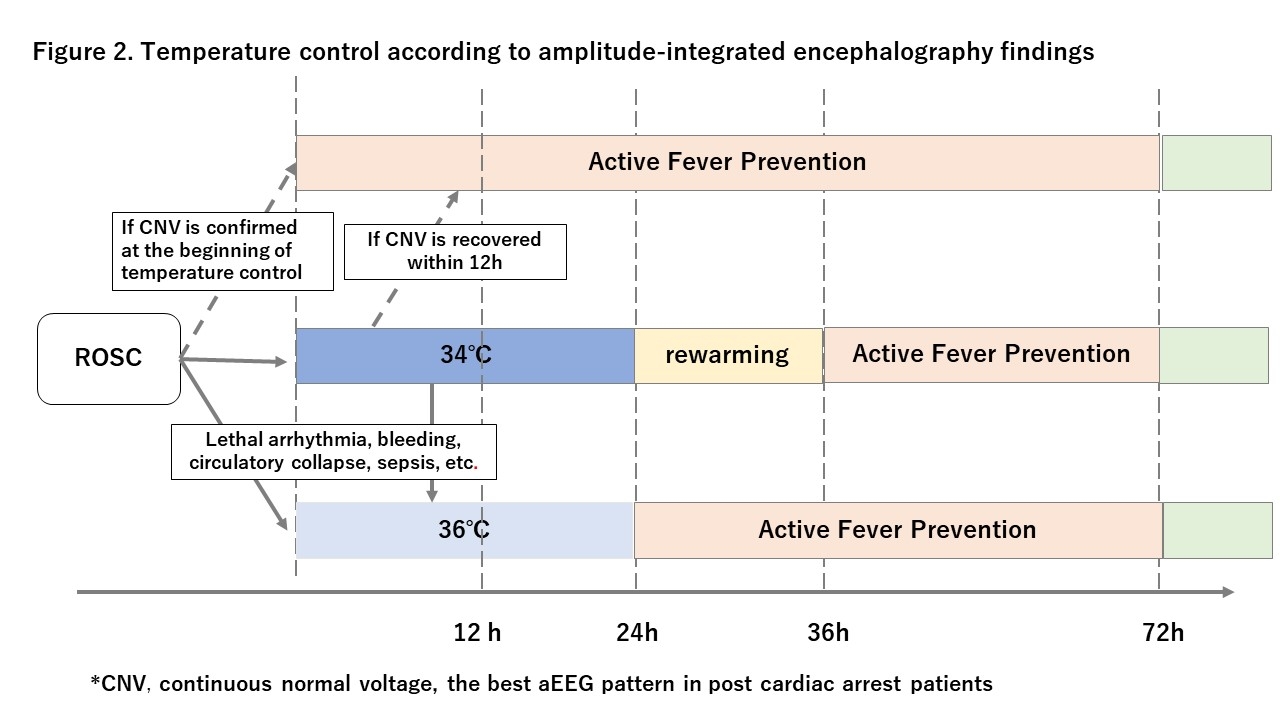Final ID: Su1202
The utility of post cardiac arrest temperature control protocol according to the severity of hypoxic encephalopathy based on amplitude-integrated electroencephalography findings
Abstract Body: Introduction
The TTM2 trial showed that active fever prevention below 37.5°C and hypothermia at 33°C had similar outcomes in out-of-hospital post cardiac arrest patients. However, the patients in the trial had mild hypoxic encephalopathy, and the effects of hypothermia may vary with its severity. We previously reported that amplitude-integrated electroencephalography (aEEG) findings after the return of spontaneous circulation can be used to categorize the severity of hypoxic encephalopathy (Crit Care. 2018;22:226). In September 2022, we adopted a new temperature control protocol wherein the target temperature was set based on aEEG findings. This study examined changes in outcomes before and after implementing this new protocol.
Methods
We assessed out-of-hospital cardiac arrest patients who received post cardiac arrest care in our emergency intensive care unit between March 2021 and February 2024. We divided the patients into two groups: before (B) and after (A) the introduction of the new protocol. We classified the patients into categories 1 (C1) to 4 (C4) based on the severity of hypoxic encephalopathy (Figure 1). All patients in group B were treated with hypothermia at 34°C. In group A, patients in C1 were treated with active fever prevention, and those in C2–C4 received hypothermia at 34°C (Figure 2). Primary outcome was favorable neurological outcomes (cerebral performance categories of 1 or 2) at hospital discharge. Secondary outcome was the duration of mechanical ventilation.
Results
A total of 160 patients were included. The median age was 62 years and 105 (66%) patients had cardiac etiology. Fifty-five (34%) patients underwent extracorporeal cardiopulmonary resuscitation. The median cardiac arrest time was 29 min. Groups B and A comprised 57 and 103 patients, respectively. C1 category comprised 20 and 28 patients in groups B and A, respectively. The rate of favorable neurological outcomes was 35% in both B and A groups (p=1.00). Regarding C1 patients, the rates were 90% and 86% in B and A groups (p=1.00). Median duration of mechanical ventilation was 5 and 3 days in group B and A, respectively (p=0.11).
Conclusion
Neurological outcomes before and after introducing the new protocol were similar. Management of patients with mild hypoxic encephalopathy can be simplified with active fever prevention. A temperature control protocol based on the severity of hypoxic encephalopathy using aEEG findings is feasible for emergency physicians.
The TTM2 trial showed that active fever prevention below 37.5°C and hypothermia at 33°C had similar outcomes in out-of-hospital post cardiac arrest patients. However, the patients in the trial had mild hypoxic encephalopathy, and the effects of hypothermia may vary with its severity. We previously reported that amplitude-integrated electroencephalography (aEEG) findings after the return of spontaneous circulation can be used to categorize the severity of hypoxic encephalopathy (Crit Care. 2018;22:226). In September 2022, we adopted a new temperature control protocol wherein the target temperature was set based on aEEG findings. This study examined changes in outcomes before and after implementing this new protocol.
Methods
We assessed out-of-hospital cardiac arrest patients who received post cardiac arrest care in our emergency intensive care unit between March 2021 and February 2024. We divided the patients into two groups: before (B) and after (A) the introduction of the new protocol. We classified the patients into categories 1 (C1) to 4 (C4) based on the severity of hypoxic encephalopathy (Figure 1). All patients in group B were treated with hypothermia at 34°C. In group A, patients in C1 were treated with active fever prevention, and those in C2–C4 received hypothermia at 34°C (Figure 2). Primary outcome was favorable neurological outcomes (cerebral performance categories of 1 or 2) at hospital discharge. Secondary outcome was the duration of mechanical ventilation.
Results
A total of 160 patients were included. The median age was 62 years and 105 (66%) patients had cardiac etiology. Fifty-five (34%) patients underwent extracorporeal cardiopulmonary resuscitation. The median cardiac arrest time was 29 min. Groups B and A comprised 57 and 103 patients, respectively. C1 category comprised 20 and 28 patients in groups B and A, respectively. The rate of favorable neurological outcomes was 35% in both B and A groups (p=1.00). Regarding C1 patients, the rates were 90% and 86% in B and A groups (p=1.00). Median duration of mechanical ventilation was 5 and 3 days in group B and A, respectively (p=0.11).
Conclusion
Neurological outcomes before and after introducing the new protocol were similar. Management of patients with mild hypoxic encephalopathy can be simplified with active fever prevention. A temperature control protocol based on the severity of hypoxic encephalopathy using aEEG findings is feasible for emergency physicians.
More abstracts on this topic:
A Case of Successful Resuscitation After Out-of-hospital Cardiac Arrest Caused by Undiagnosed Pheochromocytoma-induced Cardiomyopathy
Hatakeyama Toshihiro, Suetsugu Yusuke, Watanabe Kaoru, Matsushima Hisao
A Stroke System’s Implementation and Analysis After Transitioning to Tenecteplase, a Novel ThrombolyticMontgomery Kelly, Campbell Meghan, Fussner Julie, Traeger Jessica, Sarraj Amrou


